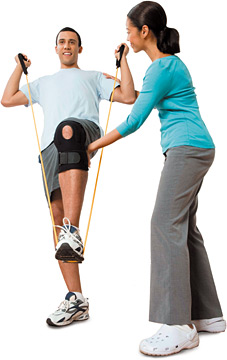The easiest form of aerobic exercise is walking. It does not require a membership and cost is limited to a good pair of shoes and flexible, custom-made orthotics (shoe inserts) for proper support. It can be performed indoors or out and does not require a great deal of athletic ability. The benefits of walking are numerous, particularly if you've suffered a soft-tissue injury. Walking will help maintain fitness and keep you mobile while your injury starts to heal.
Training Frequency
The number of times exercise is performed per week is the training frequency. The frequency may be low at first and build as your health improves. As a general rule, three sessions per week is the minimum number needed to produce noticeable results. Frequency can increase up to seven sessions per week depending upon the intensity of exercise mode chosen.
Exercise Duration
The number of minutes performed and/or distance traveled during aerobic exercise is termed the exercise duration. Treadmills, stationary bikes and other machines allow you to track one or both of these factors. In the absence of a monitor to measure distance, time can be used as the benchmark, as measured by a watch. Duration should not fall below 10 minutes. Optimal time is 20 minutes or more.
Training Intensity
 The amount of exertion or stress placed on the body is the training intensity. You may be performing all three of the above steps, but if you are not performing them with enough intensity, you will derive little benefit. For exercise to be beneficial, the intensity of the exercise must go beyond the intensity experienced during normal daily activities.
The amount of exertion or stress placed on the body is the training intensity. You may be performing all three of the above steps, but if you are not performing them with enough intensity, you will derive little benefit. For exercise to be beneficial, the intensity of the exercise must go beyond the intensity experienced during normal daily activities.
Many people will make statements like, "I walk in the factory all day at work. I don't need to walk for exercise." While walking all day is better than sitting all day, it is not exercise if it is what you do every day. The walking may not be fast enough to evoke the physical response necessary for training and improving the body. The daily activities also likely involve many stops and starts that prevent the duration of the activity from being continuous enough to be beneficial. The intensity must stress the body above normal activities, but not to the point of detriment or injury.
Monitoring Training Intensity: As a general rule of thumb, if you are not sweating after 10 minutes of exercise, then you are not achieving the minimal amount of intensity needed to improve health. On the opposite side of the coin, if you cannot carry on a conversation while exercising, then the training intensity is too high.
Heart rate is another good method for tracking intensity. To do this, subtract your age from 220 and then multiply that number by the intensity you and your doctor have selected. For example, if your doctor wants you to start at 60 percent of maximum heart rate, and you are 50 years old, then subtract 50 from 220 = 170, and then multiply 170 by .60, obtaining a target heart rate of 102 beats per minute. Monitor your heart rate during exercise to maintain the 102 level, being careful not to drop below or exceed this number.
Exercise Velocity (Pace): Intensity can also be monitored by tracking the velocity (speed) at which the exercise is performed. Obviously the higher the velocity, the higher the intensity of the exercise. Velocity must be taken into consideration with the other methods of measurements of intensity.

